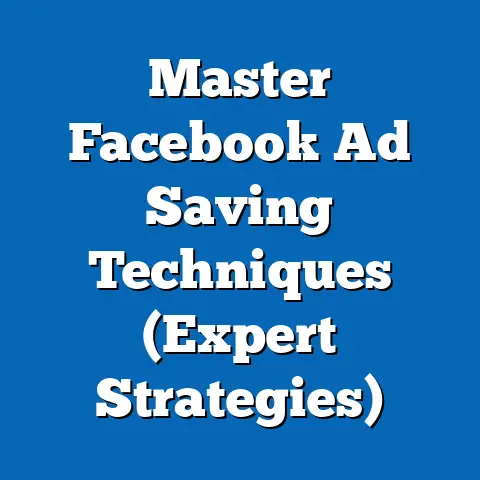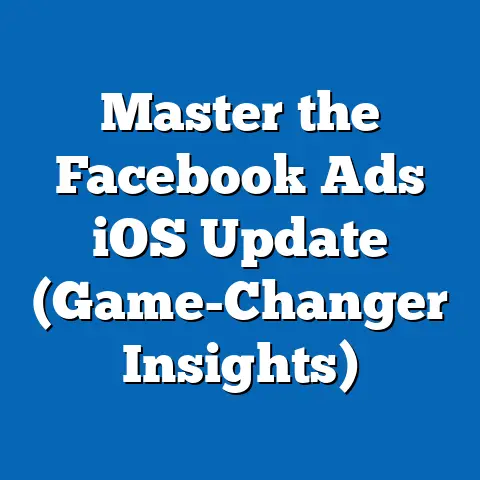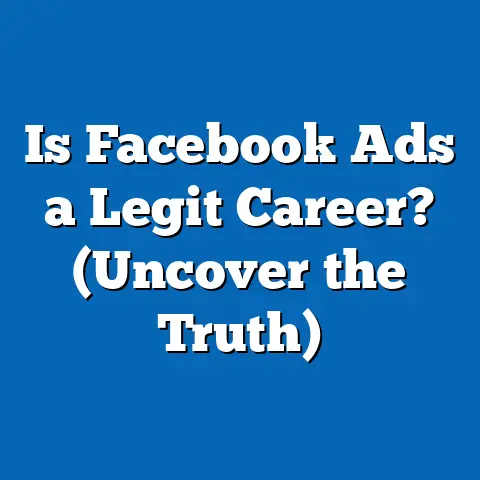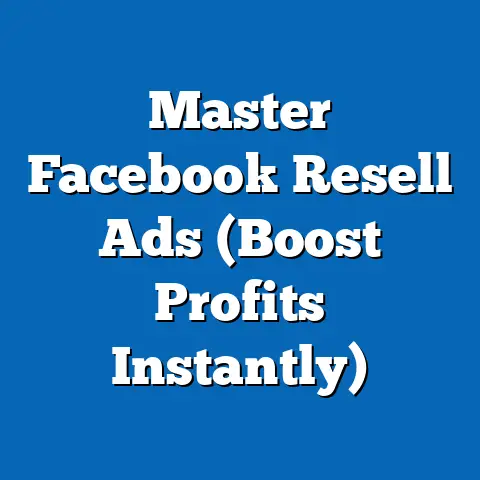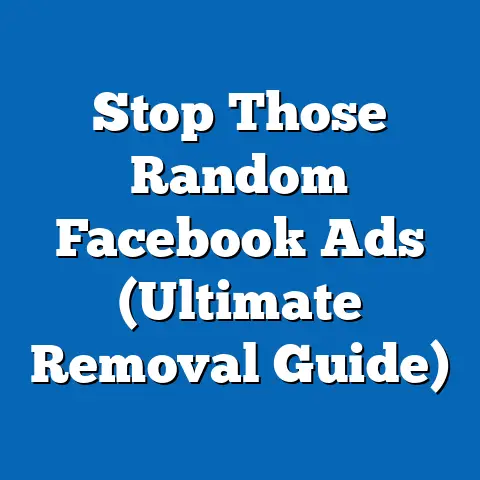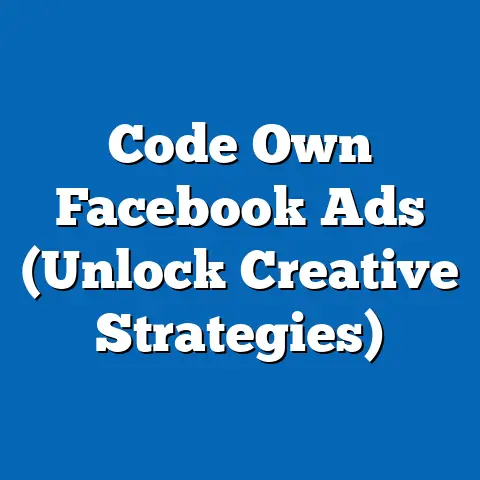Maximize Sales with Facebook Jewelry Ads (Pro Strategies)
The jewelry market has undergone a dazzling transformation, shifting from traditional storefronts to a dynamic digital landscape. In this era, investing in advertising is no longer optional; it’s a necessity for jewelry businesses aiming to thrive. Facebook, with its billions of users and sophisticated targeting capabilities, has emerged as a pivotal platform for showcasing sparkling collections and driving sales.
I’ve spent years helping businesses, including those in the jewelry sector, navigate the complexities of Facebook advertising. I’ve seen firsthand how a well-crafted campaign can transform a small artisan shop into a recognizable brand. However, I’ve also witnessed the frustration of wasted ad spend when strategies are poorly executed. That’s why I’m sharing these pro strategies – to empower you to create Facebook ads that truly shine.
Understanding Your Audience
Before diving into the creative aspects of ad creation, it’s crucial to understand who you’re trying to reach. In the jewelry niche, this is especially important because tastes and preferences vary widely. Are you targeting millennials looking for trendy, affordable pieces? Or affluent individuals seeking high-end, investment-worthy jewelry?
Facebook Audience Insights is an invaluable tool for gathering data on your target audience. You can access it through your Facebook Business Manager. I often tell clients to think of it as their personal market research assistant. It allows you to explore demographics like age, gender, location, education level, and job titles. More importantly, it reveals their interests, behaviors, and the Facebook pages they like.
For example, if you’re selling engagement rings, you might discover that your target audience is primarily women aged 25-35 who are interested in wedding planning, bridal magazines, and relationship advice. If you’re selling handcrafted artisan jewelry, you might find your audience is interested in ethical sourcing, sustainable fashion, and supporting small businesses.
Creating Customer Personas:
Once you’ve gathered data from Audience Insights, the next step is to create detailed customer personas. These are fictional representations of your ideal buyers, based on real data and insights.
-
Example: The “Eco-Conscious Emily” persona could represent a 28-year-old woman who works in the environmental sector, values sustainability, and is looking for ethically sourced jewelry. Her interests include hiking, organic food, and supporting local artisans.
-
Another Example: The “Luxury Linda” persona could represent a 45-year-old executive who appreciates high-end brands, attends social events, and is looking for statement pieces to complement her wardrobe.
Example: The “Eco-Conscious Emily” persona could represent a 28-year-old woman who works in the environmental sector, values sustainability, and is looking for ethically sourced jewelry. Her interests include hiking, organic food, and supporting local artisans.
Another Example: The “Luxury Linda” persona could represent a 45-year-old executive who appreciates high-end brands, attends social events, and is looking for statement pieces to complement her wardrobe.
By developing these personas, you can tailor your ad creative, messaging, and targeting to resonate with specific segments of your audience. It’s like having a direct line to their desires and motivations.
Key Takeaway: Understanding your audience is the foundation of successful Facebook advertising. Use Audience Insights to gather data, create customer personas, and tailor your campaigns to resonate with your target market.
Crafting Compelling Ad Creative
In the visually driven world of Facebook, your ad creative is your first chance to make a lasting impression. High-quality images, engaging video content, and compelling copy are essential for capturing attention and driving clicks. This is where I see many jewelry businesses stumble – they rely on generic stock photos or poorly written descriptions.
Visuals That Sparkle:
-
High-Resolution Images: Invest in professional photography that showcases the intricate details and craftsmanship of your jewelry pieces. Ensure your images are well-lit, properly composed, and visually appealing.
-
Engaging Video Content: Video ads are incredibly effective for showcasing the movement and sparkle of jewelry. Create short, captivating videos that highlight the unique features of your pieces. Consider showcasing how the jewelry is made or styled. I’ve found that behind-the-scenes content often resonates well with audiences.
High-Resolution Images: Invest in professional photography that showcases the intricate details and craftsmanship of your jewelry pieces. Ensure your images are well-lit, properly composed, and visually appealing.
Engaging Video Content: Video ads are incredibly effective for showcasing the movement and sparkle of jewelry. Create short, captivating videos that highlight the unique features of your pieces. Consider showcasing how the jewelry is made or styled. I’ve found that behind-the-scenes content often resonates well with audiences.
Lifestyle vs. Product-Focused Images:
-
Lifestyle Images: These images show your jewelry being worn in real-life settings. They create an aspirational feeling and help viewers visualize themselves wearing the piece. Lifestyle images are particularly effective for targeting new audiences and building brand awareness.
-
Product-Focused Images: These images focus on the jewelry itself, highlighting its details and design. They are ideal for retargeting campaigns and showcasing specific products to viewers who have already expressed interest.
Lifestyle Images: These images show your jewelry being worn in real-life settings. They create an aspirational feeling and help viewers visualize themselves wearing the piece. Lifestyle images are particularly effective for targeting new audiences and building brand awareness.
Product-Focused Images: These images focus on the jewelry itself, highlighting its details and design. They are ideal for retargeting campaigns and showcasing specific products to viewers who have already expressed interest.
Storytelling Through Ads:
Don’t just sell jewelry; tell a story. Use your ad copy to create an emotional connection with potential buyers.
-
Example: Instead of simply saying “Diamond engagement ring,” try something like “Celebrate your forever love with this exquisite diamond ring, a symbol of enduring commitment.”
-
Another Example: Instead of “Handcrafted silver necklace,” try “Embrace your unique style with this handcrafted silver necklace, a testament to artistry and individuality.”
Example: Instead of simply saying “Diamond engagement ring,” try something like “Celebrate your forever love with this exquisite diamond ring, a symbol of enduring commitment.”
Another Example: Instead of “Handcrafted silver necklace,” try “Embrace your unique style with this handcrafted silver necklace, a testament to artistry and individuality.”
I’ve seen campaigns that focus on the origin of the materials, the artisan who created the piece, or the special occasion it’s meant to celebrate perform exceptionally well.
Key Takeaway: Invest in high-quality visuals, use lifestyle images to create aspirational feelings, and craft compelling copy that tells a story. Don’t just sell jewelry; sell emotions and experiences.
Leveraging Facebook Ad Formats
Facebook offers a variety of ad formats, each with its own unique strengths and benefits. Choosing the right format can significantly impact the performance of your jewelry ads. I always advise clients to experiment with different formats to see what resonates best with their target audience.
-
Carousel Ads: These ads allow you to showcase multiple products in a single ad unit. Each image or video in the carousel has its own headline, description, and link. Carousel ads are perfect for displaying a range of jewelry pieces or highlighting different features of a single product. For example, you could use a carousel ad to showcase an engagement ring from different angles, highlighting the diamond’s cut, clarity, and carat weight.
-
Slideshow Ads: These ads combine a series of still images or videos into a slideshow format. They’re a cost-effective way to create engaging video content without the expense of a full-fledged video production. Slideshow ads are great for showcasing a collection of jewelry pieces or telling a visual story.
-
Collection Ads: These ads combine a catalog of products with a video or image. When users click on the ad, they’re taken to a full-screen experience where they can browse your products. Collection ads are ideal for driving traffic to your online store and increasing sales. Facebook offers a few different collection ad templates, so you can choose the one that best fits your needs.
Carousel Ads: These ads allow you to showcase multiple products in a single ad unit. Each image or video in the carousel has its own headline, description, and link. Carousel ads are perfect for displaying a range of jewelry pieces or highlighting different features of a single product. For example, you could use a carousel ad to showcase an engagement ring from different angles, highlighting the diamond’s cut, clarity, and carat weight.
Slideshow Ads: These ads combine a series of still images or videos into a slideshow format. They’re a cost-effective way to create engaging video content without the expense of a full-fledged video production. Slideshow ads are great for showcasing a collection of jewelry pieces or telling a visual story.
Collection Ads: These ads combine a catalog of products with a video or image. When users click on the ad, they’re taken to a full-screen experience where they can browse your products. Collection ads are ideal for driving traffic to your online store and increasing sales. Facebook offers a few different collection ad templates, so you can choose the one that best fits your needs.
Real-World Examples:
-
Example: A jewelry brand used carousel ads to showcase its new collection of gemstone earrings. Each image featured a different earring style, with a headline highlighting the gemstone’s unique properties and a link to the product page. The campaign resulted in a 30% increase in earring sales.
-
Another Example: A brand used slideshow ads to tell the story of its handcrafted jewelry-making process. The slideshow featured images of the artisan at work, highlighting the attention to detail and craftsmanship that goes into each piece. The campaign increased brand awareness and generated a positive response from viewers.
Example: A jewelry brand used carousel ads to showcase its new collection of gemstone earrings. Each image featured a different earring style, with a headline highlighting the gemstone’s unique properties and a link to the product page. The campaign resulted in a 30% increase in earring sales.
Another Example: A brand used slideshow ads to tell the story of its handcrafted jewelry-making process. The slideshow featured images of the artisan at work, highlighting the attention to detail and craftsmanship that goes into each piece. The campaign increased brand awareness and generated a positive response from viewers.
Key Takeaway: Experiment with different Facebook ad formats to find the ones that resonate best with your target audience. Carousel ads are great for showcasing multiple products, slideshow ads are perfect for telling visual stories, and collection ads are ideal for driving traffic to your online store.
Targeting and Retargeting Strategies
Effective targeting is the key to reaching the right audience with your Facebook ads. Facebook offers a range of targeting options, including demographic targeting, interest-based targeting, and behavioral targeting. But to truly maximize your ROI, you need to leverage advanced targeting techniques like lookalike audiences and custom audiences.
Lookalike Audiences:
These audiences allow you to reach new people who are similar to your existing customers. Facebook analyzes the characteristics of your customer base and identifies users with similar interests, behaviors, and demographics. This is one of my go-to strategies when I want to expand reach without sacrificing relevance.
- Example: Create a lookalike audience based on your existing customers who have made a purchase in the past year. This will allow you to reach new people who are likely to be interested in your jewelry pieces.
Custom Audiences:
These audiences allow you to target people who have already interacted with your business in some way. You can create custom audiences based on website visitors, email lists, app users, or Facebook page engagers.
Retargeting:
Retargeting is a powerful technique that involves showing ads to people who have previously visited your website or interacted with your Facebook page. It’s like giving them a gentle nudge to remind them about your products.
- Example: Retarget people who have viewed specific product pages on your website but haven’t made a purchase. Show them ads featuring the products they viewed, along with a special offer or discount.
Tips for Setting Up Retargeting Campaigns:
-
Use Dynamic Product Ads: These ads automatically show products that users have previously viewed on your website.
-
Create a Sense of Urgency: Use limited-time offers or discounts to encourage users to make a purchase.
-
Segment Your Retargeting Audiences: Tailor your ads to specific segments of your audience based on their past behavior.
Use Dynamic Product Ads: These ads automatically show products that users have previously viewed on your website.
Create a Sense of Urgency: Use limited-time offers or discounts to encourage users to make a purchase.
Segment Your Retargeting Audiences: Tailor your ads to specific segments of your audience based on their past behavior.
I’ve seen retargeting campaigns boost conversion rates by as much as 50%. It’s a cost-effective way to turn potential customers into loyal buyers.
Key Takeaway: Leverage advanced targeting techniques like lookalike audiences and custom audiences to reach the right people with your Facebook ads. Use retargeting to remind potential customers about your products and encourage them to make a purchase.
Analyzing and Optimizing Ad Performance
Running Facebook ads is not a “set it and forget it” activity. It requires constant monitoring, analysis, and optimization to ensure you’re getting the best possible results. It’s like tending to a garden – you need to nurture it, prune it, and adjust your approach as needed.
Key Performance Indicators (KPIs):
-
Click-Through Rate (CTR): This measures the percentage of people who click on your ad after seeing it. A high CTR indicates that your ad creative and targeting are resonating with your audience.
-
Cost Per Click (CPC): This measures the average cost you pay for each click on your ad. A low CPC indicates that your ads are efficient and cost-effective.
-
Conversion Rate: This measures the percentage of people who take a desired action, such as making a purchase, after clicking on your ad. A high conversion rate indicates that your landing page and product offerings are compelling.
-
Return on Ad Spend (ROAS): This measures the revenue you generate for every dollar you spend on advertising. A high ROAS indicates that your ads are profitable.
Click-Through Rate (CTR): This measures the percentage of people who click on your ad after seeing it. A high CTR indicates that your ad creative and targeting are resonating with your audience.
Cost Per Click (CPC): This measures the average cost you pay for each click on your ad. A low CPC indicates that your ads are efficient and cost-effective.
Conversion Rate: This measures the percentage of people who take a desired action, such as making a purchase, after clicking on your ad. A high conversion rate indicates that your landing page and product offerings are compelling.
Return on Ad Spend (ROAS): This measures the revenue you generate for every dollar you spend on advertising. A high ROAS indicates that your ads are profitable.
A/B Testing:
A/B testing involves creating multiple versions of your ads and testing them against each other to see which performs best. You can test different ad creatives, headlines, descriptions, targeting options, and placements.
- Example: Create two versions of your ad, one with a lifestyle image and one with a product-focused image. Run both ads simultaneously and track their performance to see which generates more clicks and conversions.
Facebook Analytics and Business Manager Tools:
Facebook provides a range of tools for monitoring and analyzing your ad performance. Facebook Analytics allows you to track user behavior on your website and app, while Business Manager provides a comprehensive overview of your ad campaigns.
Key Takeaway: Track your KPIs, conduct A/B testing, and use Facebook Analytics and Business Manager tools to monitor and analyze your ad performance. Continuously refine your advertising strategies based on data and insights to maximize your ROI.
Conclusion
Investing in Facebook ads is a strategic imperative for jewelry businesses aiming to maximize sales in today’s digital age. By understanding your audience, crafting compelling ad creative, leveraging the right ad formats, implementing advanced targeting techniques, and continuously optimizing your ad performance, you can create Facebook ads that truly shine.
These strategies aren’t just theoretical concepts; they’re the result of years of hands-on experience and proven success. I encourage you to implement these strategies and monitor their effects on your jewelry sales. Remember, the key to success is to be data-driven, adaptable, and always willing to experiment. With the right approach, you can transform your Facebook ads into a powerful engine for growth and build lasting brand loyalty.
Now, go out there and create some sparkling ad campaigns! I’m confident that with these pro strategies, you’ll see a dazzling return on your investment.

